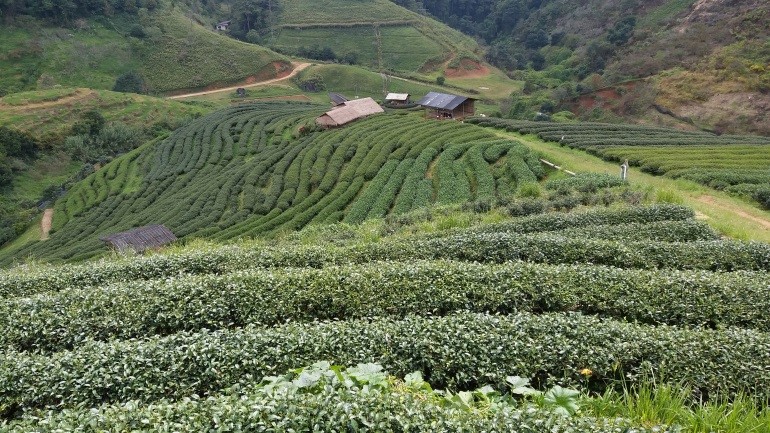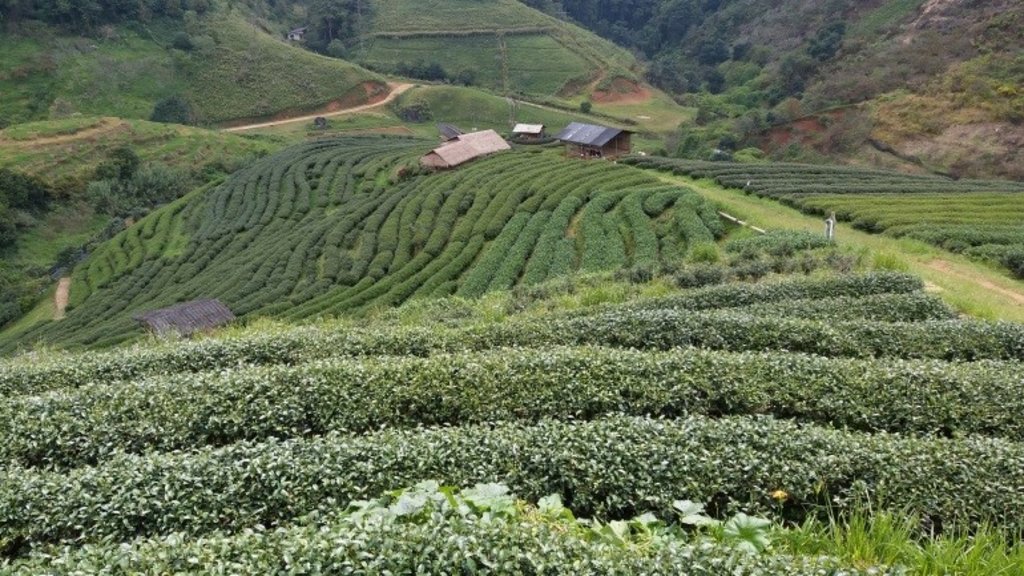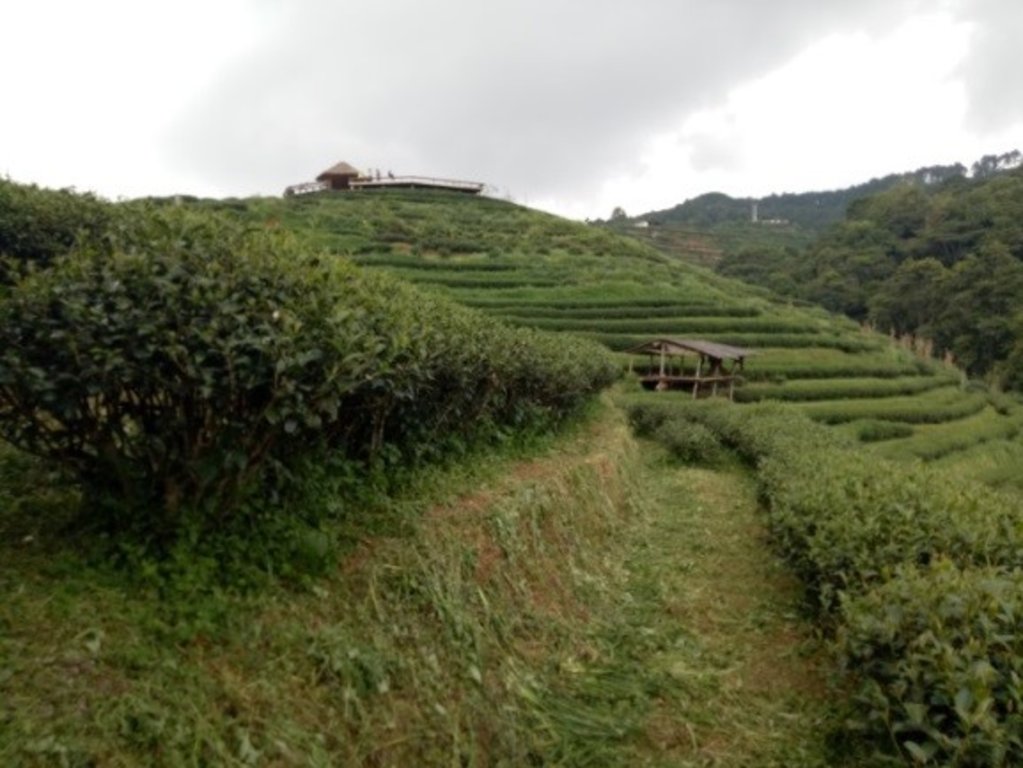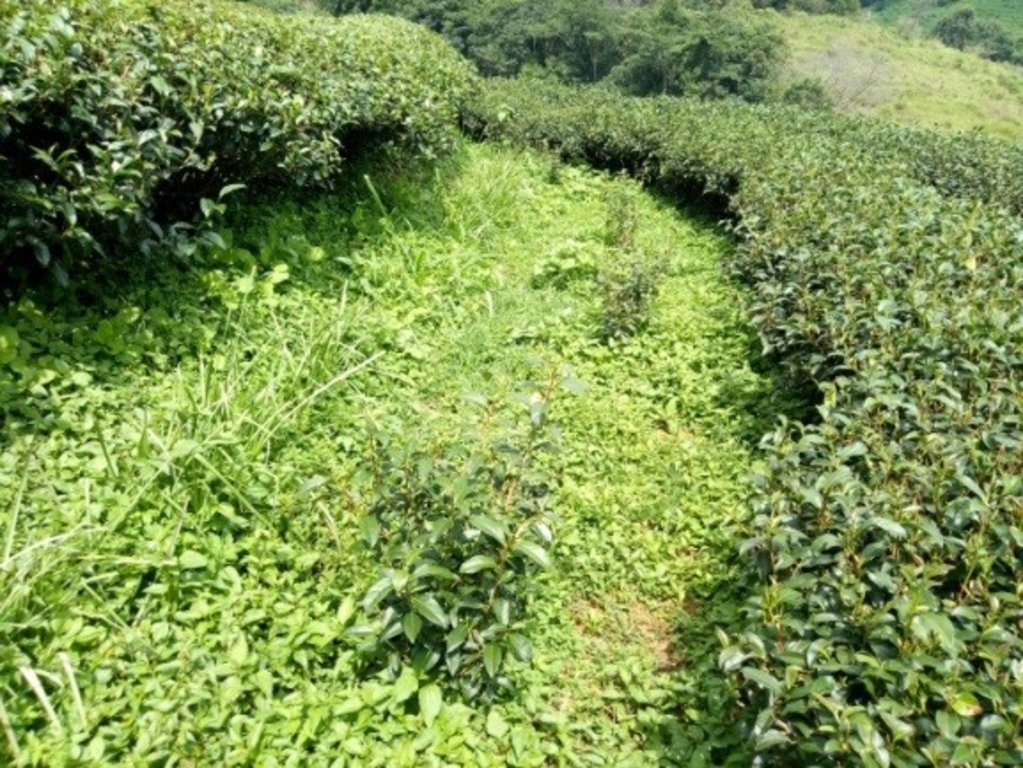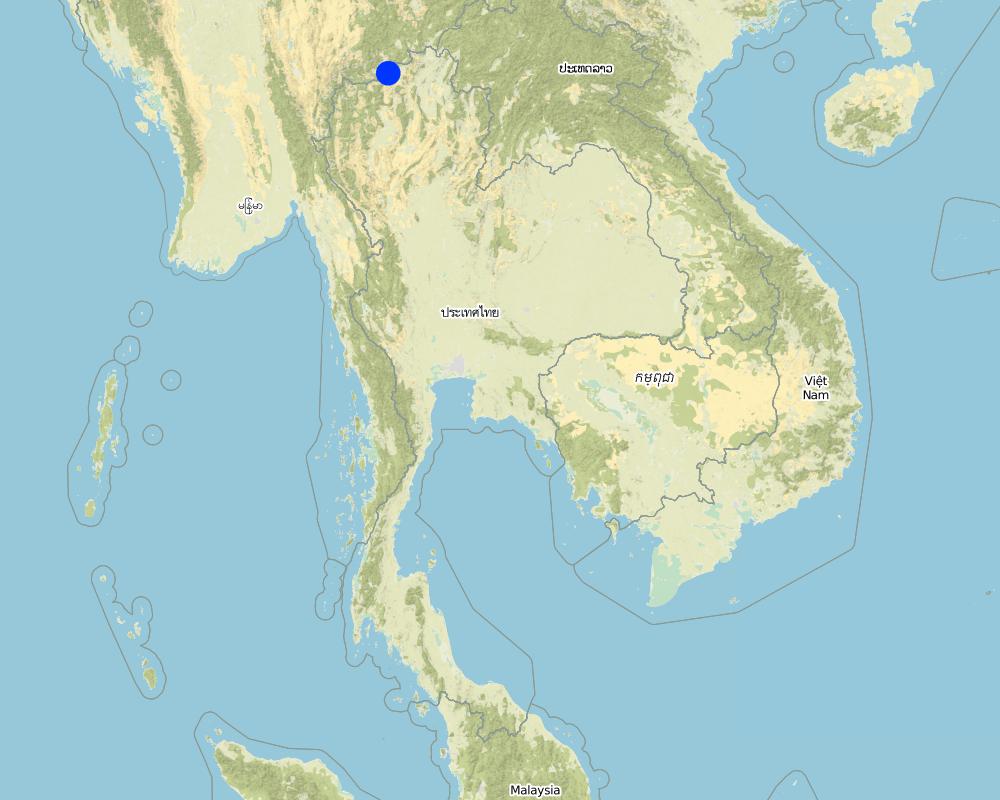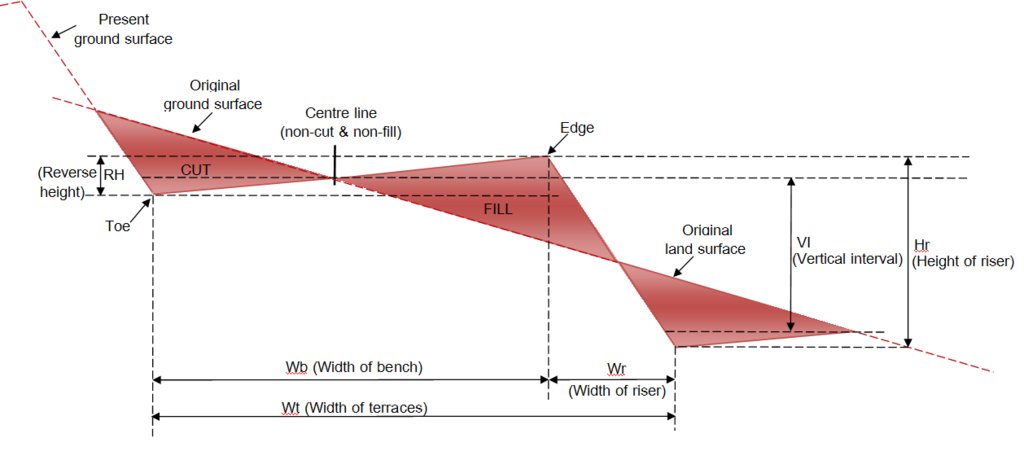Continuous bench terrace in high sloping area for tea plantation [Thailand]
- Creation:
- Update:
- Compiler: Pitayakon Limtong
- Editor: –
- Reviewer: Rima Mekdaschi Studer
Continuous bench terrace in high sloping area for tea plantation
technologies_4281 - Thailand
View sections
Expand all Collapse all1. معلومات عامة
1.2 Contact details of resource persons and institutions involved in the assessment and documentation of the Technology
Key resource person(s)
co-compiler:
Tipvong Tanomkwan
Land Development Department
Thailand
land user:
Mokngoen Jai
Palaung hill tribe farmer
Thailand
Local officer of Station:
Tapangtong Werapong
Angkhang Royal Agricultural Station
Thailand
local officer of LDD:
Boonchoo Sontaya
Royal Project Land Development Center, Land Development Department
Thailand
Name of the institution(s) which facilitated the documentation/ evaluation of the Technology (if relevant)
Land Development Department (Land Development Department) - Thailand1.3 Conditions regarding the use of data documented through WOCAT
The compiler and key resource person(s) accept the conditions regarding the use of data documented through WOCAT:
نعم
1.4 Declaration on sustainability of the described Technology
Is the Technology described here problematic with regard to land degradation, so that it cannot be declared a sustainable land management technology?
لا
Comments:
This continuous bench terrace with 3 meters base in slopping highland constructed at Plot 2000 for Chinese tea plantation. Such conservation measure can decrease soil erosion and runoff, and this slopping area can use for agriculture and increase land users products and income.
2. Description of the SLM Technology
2.1 Short description of the Technology
Definition of the Technology:
Utilization of continuous bench terrace (3 meters based) as sustainable soil and water conservation measure for tea plantation in slopping area of the northern Thailand
2.2 Detailed description of the Technology
Description:
The continuous bench terrace (forward-sloping terrace) as soil and water conservation measure in the high landscape at Angkhang Royal Agricultural Station, Moo 5, Mae Ngon subdistrict, Fang district, Chiang Mai province was constructed in 1999 in the area of former winter fruit plantation plot of the station. Land Development Department had surveyed, designed and constructed the 3 meters wide of continuous bench terrace, which it is suitable for the tea cultivation and total area is approximately 100 rai. The Angkhang Royal Agricultural Station had selected 50 households of Palaung hill tribe who have more ability and aptitude to grow Chinese tea to participate in the Chinese tea development and promotion project in 2000 and named this area as "Plot 2000". The overview of this area is complex mountainous terrain with slope range 16-30 percent, and average attitude is 1,400 meters above sea level. The soil texture is silty loam and very deep (more tan 1.2 meter), almost well drained soil. The soil organic matter is moderate around 1-3 percent. Moreover, the data of Doi Ang Khang Meteorological Station (Station Code 48302) is located at average attitude 1,529 meters above the sea level, and average temperature throughout the year is 22.9 Celsius with the highest temperature is 32.1 Celsius (during May) and the lowest temperature is 3.9 Celsius (during December), and average annual rainfall is 1,925.3 mm, with rain starting from April to October.
In the past, the watershed areas in northern Thailand have been disturbed by natural disasters, climate change, and human threats. The hill tribe people had invaded the forest to grow opium and shifting cultivation continuously. These condition caused the serious problem in soil erosion, runoff with soil surface, lose of topsoil and plant nutrients, decreasing in soil fertility and productivity with the extremely damage to upstream forest ecosystem. Until in the year 1969, Angkhang Royal Agricultural Station was established from the initiative of His Majesty King Rama 9, which aimed to conduct research on the planting of winter economic crops as an example for hill tribe to plant those crops as their career instead of opium cultivation, and also stop cutting and shifting cultivation. Nowadays there are more than 50 species of economic plants in this project and generating more income for land users, more than that this slopping area is the sustainable in land use and land management under organization of the Royal Project Foundation.
The benefits this technology is important in sustainable utilization of land resources in this area, and all land users around the Angkhang Royal Agricultural Station have stable and more income because they can grow Chinese tea and also other winter economic crops on this highland throughout the year. Moreover, this continuous bench terrace is more convenient for land users in fertilizer application, soil improvement, machines operation, tea harvesting and also yield transportation from cultivated plots to local processing factory.
The impact of implementation continuous bench terrace with 3 meters based:
1. The obvious economic and social impacts of land users are the stability of income from the production of Chinese tea, which are produced throughout the year. This conservation is more convenient for land users to implement in their plot and also transport from cultivated plots to local processing factory. The local officers from Angkhang Royal Agricultural Station and others government agencies closely advised and guided breeding, planting, soil management, harvesting and price guarantee.
2. The environmental and ecological impact is to reduce the amount of runoff and soil sediment, increase soil moisture, preserve soil nutrients and fertility, encourage biodiversity in the area of Plot 2000.
3. The society and culture impact is all ethnic groups are given the opportunity to receive the allocation of arable land according to the group of plants that they are comfortable and want to produce. Thus respecting the use of land in zoning as allocated from the station, including right to use water. These caused the strength of community institutions, where they have various crop production groups, organic fertilizer production Group and others. They are all member of the cooperative of the community.
2.3 Photos of the Technology
General remarks regarding photos:
Soil and water conservation measure (3-meter base) as continuous bench terrace with Chinese tea cultivation on highland (at Plot 2000). The winter fruit trees in this area of AngKhang Royal Agricultural Station has been changed to the bench terrace for Chinese tea plantation with good agricultural practices (GAP) more than 19 years, which shows the appropriate land use conditions in sustainable soil and water conservation.
2.4 Videos of the Technology
Date:
14/10/2018
الموقع:
Ban Thap Sub-District, Mae Chaem District, Chiang Mai Province, 50270
Name of videographer:
Ms. Somjit Lertdisayawan / Ms. Tanomkwan Tipvong
2.5 Country/ region/ locations where the Technology has been applied and which are covered by this assessment
بلد:
Thailand
Region/ State/ Province:
Ban Thap Sub-District, Mae Chaem District, Chiang Mai Province, 50270
Further specification of location:
Extension area for Chinese tea plantation (Plot 2000) at Angkhang Royal Agricultural Station, Mae Ngon Subdistrict, Fang District, Chiang Mai ProvincePlot
Specify the spread of the Technology:
- evenly spread over an area
If precise area is not known, indicate approximate area covered:
- 0.1-1 km2
Comments:
Angkhang Royal Agricultural Station is an area for research and development for the winter crops and trees around 1,811 rai, with high from the sea level 1,400 meters. There are hill tribe villages around the station and the total population is about 3,215 people. The weather is cool all year round with the average temperature is 17.7 degrees, the maximum temperature is 32 degrees in April. And the minimum temperature of -3 degrees in January. The average rainfall is 2,075 mm per year and slope area 20-35%.
Map
×2.6 Date of implementation
Indicate year of implementation:
1999
If precise year is not known, indicate approximate date:
- 10-50 years ago
2.7 Introduction of the Technology
Specify how the Technology was introduced:
- through projects/ external interventions
Comments (type of project, etc.):
The Royal Project implement in the upstream forest area and emphasize to promote and encourage career of hilltribe land users around AngKhang Agricultural Station. Moreover, the continuous bench terrace is introduced in this high slope area to prevent and conserve soil and water resources, reduce soil erosion and runoff.
3. Classification of the SLM Technology
3.1 Main purpose(s) of the Technology
- improve production
- reduce, prevent, restore land degradation
- conserve ecosystem
- preserve/ improve biodiversity
- create beneficial economic impact
3.2 Current land use type(s) where the Technology is applied

الأراضي الزراعية
- Perennial (non-woody) cropping
- Tea
Number of growing seasons per year:
- 1
حددها:
Chinese tea, Camellia sinensis var. sinensis in 15.43 sq.km. or 96.4375 Rai.
Comments:
Palaung hill tribe will plant Chinese tea on this area in late rainy season, about August to October because after planting root of tea would grow well in the cool condition and do not face problems like during the rainy season. The trimming will be about 10-12 months before planting. spacing between row is 1.2 meter and between tree is 60 centimeters. There are about 2,200 trees per Rai.
3.3 Has land use changed due to the implementation of the Technology?
Comments:
-
3.4 Water supply
Water supply for the land on which the Technology is applied:
- mixed rainfed-irrigated
Comments:
The land use in this area is Chinese tea in Plot 2000, with 2 species, namely soft stalks and variety no.12, This area is mainly rain fed together with spraying system. And water supply system is in the upper part of the area and distribute to tea plot by PVC pipe and set springier cover over this plot. however, this water system is high cost but it is worthwhile.
3.5 SLM group to which the Technology belongs
- cross-slope measure
- ecosystem-based disaster risk reduction
3.6 SLM measures comprising the Technology

vegetative measures
- V2: Grasses and perennial herbaceous plants

structural measures
- S1: Terraces
Comments:
The continuous bench terrace technology is suitable soil and water conservation in slopping area,where is the upper part of watershed in the National Reserved Forest area. This technology need knowledge and expertise in construction of conservation measure with high investment and more maintenance. That means government and private sector should support in construction and land users should maintain of bench terrace and take care in soil fertility.
3.7 Main types of land degradation addressed by the Technology

soil erosion by water
- Wt: loss of topsoil/ surface erosion
Comments:
Soil resources in this area is degraded by deforestation and climate changes, where it is risk in runoff and soil erosion. In this case plant nutrients in soil surface and sediment is removed to the low part, soil fertility is decreased, and ecosystem in upstream forest is degraded.
3.8 Prevention, reduction, or restoration of land degradation
Specify the goal of the Technology with regard to land degradation:
- prevent land degradation
- reduce land degradation
Comments:
In 1999, the Angkhang Royal Agricultural Station cooperated with Land Development Department construct the continuous bench terrace and soil improvement in this steep slope area to prevent soil erosion and runoff. Moreover, the Royal Irrigation Department support water supply system and the Provincial Electricity Authority support electricity services.
4. Technical specifications, implementation activities, inputs, and costs
4.1 Technical drawing of the Technology
Technical specifications (related to technical drawing):
Operation in tea plantation in Plot 2000:
1. During 1999-2000, Angkhang Royal Agricultural Station, in collaboration with Land Development Department, conducted a survey to select the highland mountainous area with slope 20-35 percent, where land is deteriorated conditions, risk of erosion and landslides, low fertility. In order to design and construct soil and water conservation measure as continuous bench terrace with 3 meters based for Chinese tea plantations as a plot to demonstrate and promote the conservation measure on such area for Palaung hill tribe. Soil in this area is Mae Taeng soil series where it is very deep soil, with texture is sandy loam to sandy loamy, dark brown in color and soil reaction is slightly acidic (pH 5.5-6.5). In lower layer of soil profile is clay, dark red to red and soil reaction is very acidic to acidic (pH 4.5-5.5)
2. Set up the digging contour line by using wood pole from the highest point of the area to the lowest point and used the upper line is the first line of the terrace. Then dig the next contour line down along the slope and distance between the contour line is equal to distance of each terrace that is 3 meters. After that dig the terrace as 3 meters based on the contour line and set the level of terrace inclined around 1-2 degrees to drain water from this area.
3. The operation of cut and fill of soil along the contour line and move the surface soil and reshape the surface soil in this area. And dig the soil by using manpower or machine from the lower edge of the plot to make the terrace in the upper part. Therefore move, adjust and compact the soil in this area and reshape surface of soil and make terrace with 3.0 meters width and incline about 1-2 degrees, and make additional 10 percent of soil thickness to prevent the collapse, and keep the soil organic matter on the upper part of the floor and height of each terrace should not more than 1.8 meters, therefore cutting the soil down to 0.9 meters and filling the soil 0.9 meters.
4. Vetiver grass plantation conserved 2 rows of terrace by planting over the top of the terrace and planting another 1 row over the filled soil and planting spacing is 10 centimeters.
5.1 After bench terrace construction is completed in 2000, where Angkhang Royal Agricultural Station selected land users and allocated land for tea plantation for 50 households of Palaung hill tribe to set experiment of 2 varieties of Chinese tea as soft stem and breed number 12 varieties.
5.2 Land users usually planted Chinese tea at late of rainy season, which is about August to October as suitable planting season. Because after planting in this period, the root of the tea will affect the cold condition that make they grow well and do not face problems like during the rainy season
5.3 The planting period of the cutting stalk will be about 10-12 months before planting. The planting spacing is 1.2 meters in length. The spacing between stalk is 60 centimeters, and spaced about 40-45 centimeters in a row. There are approximately 2,200 trees per rai.
6. Maintenance of Plot 2000
6.1 Fertilizer application focuses on using compost from animal manure produced by this group. By digging a long groove at the end of the canopy of tea about 15 cm deep on both sides. Compost is applied 2 kilograms per tree a year, and apply 3 times during February, June, October and also use bio-extracted solution spray to tea tree for stretching the shoot with dark green leaf, plump, good weight.
6.2 Irrigation in this area use both from rain and water storage tank in the upper area and distribute directly to the plot by PVC pipe.
6.3 Almost land users in this area harvested their organic tea from April to December and will donant during January-March. At present, the no.12 variety has average yield 800 kilograms per rai, they can harvest 5-6 times a year, while the soft stem variety has average yield 600 kilograms per rai, and can harvest 4-5 times a year. In this case they would have total annual yield 60,000 kilograms and annual average income is 100,000-300,000 baht per household.
7. Maintenance of bench terrace in case of damage by runoff, all land users will repair their terrace by themselves in the dry season. In the serious case of erosion, Land Development Department will support such maintenance at rate of 500 baht per rai.
Author:
Ms. Tanomkwan Tipvong
4.2 General information regarding the calculation of inputs and costs
Specify how costs and inputs were calculated:
- per Technology area
Indicate size and area unit:
The area of continuous bench terrace 3 meter board
If using a local area unit, indicate conversion factor to one hectare (e.g. 1 ha = 2.47 acres): 1 ha =:
15.43
other/ national currency (specify):
Baht
If relevant, indicate exchange rate from USD to local currency (e.g. 1 USD = 79.9 Brazilian Real): 1 USD =:
15448,6
Indicate average wage cost of hired labour per day:
175.82
4.3 Establishment activities
| Activity | Timing (season) | |
|---|---|---|
| 1. | Survey, select the area and design conservation measure | the first year (1998) |
| 2. | set up contour line for terrace | the first year (1998) |
| 3. | construct bench terrace | before of rainy season 1999 |
| 4. | Vetiver grass plantation on the terrace | early of rainy season 1999 |
| 5. | Chinese tea plantation | in rainy season, Aug-Oct 2000 |
| 6. | Fertilizer application 3 times | Feb, Jun and Oct |
| 7. | Water application | throughout the planting period |
| 8. | Fertilizer application | throughout the planting period |
| 9. | Harvest | harvesting period |
| 10. | Maintenance bench terrace | in dry season, April |
Comments:
-
4.4 Costs and inputs needed for establishment
| Specify input | Unit | Quantity | Costs per Unit | Total costs per input | % of costs borne by land users | |
|---|---|---|---|---|---|---|
| Labour | site survey 1 day | man | 0,5 | 175,82 | 87,91 | |
| Labour | set up contour line 1 day | man | 4,0 | 175,82 | 703,28 | |
| Labour | vetiver planting (400 slips x 8 rows) | slip | 3200,0 | 1,65 | 5280,0 | |
| Labour | man power (2.4 cu.m./m.) | cu.m. | 88,0 | 100,88 | 8877,44 | |
| Equipment | machine power (2.4 cu.m./m.) | cu.m. | ||||
| Equipment | pin wood | unit | 100,0 | 5,0 | 500,0 | |
| Plant material | vetiver slip (LDD supported) | None | 3200,0 | |||
| Total costs for establishment of the Technology | 15448,63 | |||||
| Total costs for establishment of the Technology in USD | 1,0 | |||||
If land user bore less than 100% of costs, indicate who covered the remaining costs:
Land Development Department by Center of land development for Royal Project supported the budget by conduct the bench terrace in this area.
Comments:
-
4.5 Maintenance/ recurrent activities
| Activity | Timing/ frequency | |
|---|---|---|
| 1. | maintain and repair bench terrace | in dry season 3-5 years/time |
Comments:
In the case of bench terrace are not so much damaged, and size of rill is around 5-20 cm. wide and not very deep. Most of the land users usually repair that terrace by themselves during the dry season.
4.6 Costs and inputs needed for maintenance/ recurrent activities (per year)
| Specify input | Unit | Quantity | Costs per Unit | Total costs per input | % of costs borne by land users | |
|---|---|---|---|---|---|---|
| Labour | man power to repair the terrace | man | 1,0 | 500,0 | 500,0 | 100,0 |
| Total costs for maintenance of the Technology | 500,0 | |||||
| Total costs for maintenance of the Technology in USD | 0,03 | |||||
If land user bore less than 100% of costs, indicate who covered the remaining costs:
All maintenance cost of bench terrace are supported by Center of Land Development for Royal Project, Land Development Department.
Comments:
Center of Land Development for Royal Project, Land Development Department directly cooperated with the Royal Project.
4.7 Most important factors affecting the costs
Describe the most determinate factors affecting the costs:
construction of continuous bench terrace and maintenance cost, which it is all invested by government sector, Land Development Department.
5. Natural and human environment
5.1 Climate
Annual rainfall
- < 250 mm
- 251-500 mm
- 501-750 mm
- 751-1,000 mm
- 1,001-1,500 mm
- 1,501-2,000 mm
- 2,001-3,000 mm
- 3,001-4,000 mm
- > 4,000 mm
Specify average annual rainfall (if known), in mm:
1925,30
Specifications/ comments on rainfall:
The number of rainy day is 160.9 days per year. The day with the highest daily rain (daily max.) average 149.4 mm/day in October. The number of day has storm average of 57.5 days and highest per year in May is 10.5 days
Indicate the name of the reference meteorological station considered:
Doi Angkang (Index station 48302), 19° 55' 53.0" N and 99° 2' 54.0" E, at attitude MSL 1529 m. (2006-2015)
Agro-climatic zone
- sub-humid
According to data from climatic station 48302 , it is found that the duration of the precipitation period is more than half of the evaporation potential (PET) between May-October or about 6 months (180 days).
5.2 Topography
Slopes on average:
- flat (0-2%)
- gentle (3-5%)
- moderate (6-10%)
- rolling (11-15%)
- hilly (16-30%)
- steep (31-60%)
- very steep (>60%)
Landforms:
- plateau/plains
- ridges
- mountain slopes
- hill slopes
- footslopes
- valley floors
Altitudinal zone:
- 0-100 m a.s.l.
- 101-500 m a.s.l.
- 501-1,000 m a.s.l.
- 1,001-1,500 m a.s.l.
- 1,501-2,000 m a.s.l.
- 2,001-2,500 m a.s.l.
- 2,501-3,000 m a.s.l.
- 3,001-4,000 m a.s.l.
- > 4,000 m a.s.l.
Indicate if the Technology is specifically applied in:
- not relevant
Comments and further specifications on topography:
This technology is used in slope 20-35% , slope complex and slope more than 35%.
5.3 Soils
Soil depth on average:
- very shallow (0-20 cm)
- shallow (21-50 cm)
- moderately deep (51-80 cm)
- deep (81-120 cm)
- very deep (> 120 cm)
Soil texture (topsoil):
- medium (loamy, silty)
Soil texture (> 20 cm below surface):
- fine/ heavy (clay)
Topsoil organic matter:
- medium (1-3%)
If available, attach full soil description or specify the available information, e.g. soil type, soil PH/ acidity, Cation Exchange Capacity, nitrogen, salinity etc.
Angkhang Royal Agricultural Station is directly respond covered 16,577 rai, with 5 main villages, namely Ban Nala, Ban Rim, Ban Pang Ma, Ban Khum, and Ban Luang. Total population is 3,929 people. The overall landscape is slope complex in mountain range surrounded by a pan-shaped basin. This agricultural area is promoted the hill tribe community to grow winter crops. The general condition of this area is pine forest and evergreen forest. The attitude is 1,400 meters above the sea level. Most of soil series are Ban Luang Series. Soil loamy soil. Angkhang Series is a soil formed by limestone, rock, shell, shale. The overall soil condition is good structure, but almost highland with high slope and acidic condition (pH 4.5-6.0).
5.4 Water availability and quality
Ground water table:
> 50 m
Availability of surface water:
good
Water quality (untreated):
for agricultural use only (irrigation)
Is water salinity a problem?
لا
Is flooding of the area occurring?
لا
Comments and further specifications on water quality and quantity:
In the past, there was no soil and water conservation measure, where soil erosion and severe runoff is occurred when it has heavy rain, especially during the rainy season. Soil surface was transported to the lower part, where organic matter and plant nutrients lost from this area and small rill and deep groove is formed in the upper part. Moreover such soil sediment in runoff accumulated in the channel and natural reservoir.
5.5 Biodiversity
Species diversity:
- high
Habitat diversity:
- medium
Comments and further specifications on biodiversity:
In Plot 2000 can observe several insects in both of predators and parasitic insects such as dragonflies, beetles, turtles, striped mungs, ants, also earthworm and others.
5.6 Characteristics of land users applying the Technology
Sedentary or nomadic:
- Sedentary
Market orientation of production system:
- mixed (subsistence/ commercial)
Off-farm income:
- less than 10% of all income
Relative level of wealth:
- average
Individuals or groups:
- groups/ community
Level of mechanization:
- manual work
Gender:
- women
- men
Age of land users:
- youth
- middle-aged
- elderly
Indicate other relevant characteristics of the land users:
All land users and their family members worked in their land such as tea leaves harvest, weed control, fertilizer application, tea planting, trimming and others, which they would not prefer to hire workers.
5.7 Average area of land used by land users applying the Technology
- < 0.5 ha
- 0.5-1 ha
- 1-2 ha
- 2-5 ha
- 5-15 ha
- 15-50 ha
- 50-100 ha
- 100-500 ha
- 500-1,000 ha
- 1,000-10,000 ha
- > 10,000 ha
Is this considered small-, medium- or large-scale (referring to local context)?
- small-scale
Comments:
The leader of Plot 2000 (Mr. Chai) has land for tea plantation 4 rai. and also Jiaogulan herb plantion 1 rai, and rental land for agriculture 1 rai.
5.8 Land ownership, land use rights, and water use rights
Land ownership:
- individual, not titled
Land use rights:
- communal (organized)
Water use rights:
- communal (organized)
حددها:
-
Comments:
All land users in this area would not right in land ownership but they have right to use these land for agricultural purposes. And Angkhang Royal Agricultural Station separated and allocated these land for selected land users and also land zoning for fruit trees, Vegetables, flowers and ornamental plants and others.
5.9 Access to services and infrastructure
health:
- poor
- moderate
- good
education:
- poor
- moderate
- good
technical assistance:
- poor
- moderate
- good
employment (e.g. off-farm):
- poor
- moderate
- good
markets:
- poor
- moderate
- good
energy:
- poor
- moderate
- good
roads and transport:
- poor
- moderate
- good
drinking water and sanitation:
- poor
- moderate
- good
financial services:
- poor
- moderate
- good
Comments:
They have cooperative activity to support investment and production costs such as fertilizers, bio-pesticides, pesticides and others.
6. Impacts and concluding statements
6.1 On-site impacts the Technology has shown
Socio-economic impacts
Production
crop production
Comments/ specify:
In former time land users use shifting cultivation for corn and upland rice. After organic tea farming had set up at Plot 2000 their products and income were increased and can harvest throughout the year.
risk of production failure
Comments/ specify:
They have advised from stations' staff and promote varieties, planting, production, harvest, purchase, insurance price. There are tea processing factories in the market, making tea production sustainable (integrated)
production area
Comments/ specify:
this area can not extend.
land management
Comments/ specify:
After this system has been allocated for organic tea in the Plot 2000, where soil conservation measure and soil management is need.
Water availability and quality
demand for irrigation water
Comments/ specify:
This system need more water continuously.
Income and costs
expenses on agricultural inputs
Comments/ specify:
This system need to maintain the terrace and more work to take care tea tree.
farm income
Comments/ specify:
They have more income from tea product continuously.
economic disparities
Comments/ specify:
They have equal opportunities in earning their life.
workload
Comments/ specify:
They have more workload almost daily and continuously because they need to intensive care on terrace construction and tea tree.
Socio-cultural impacts
land use/ water rights
Comments/ specify:
This system had set up zoning system for some crop by Angkhak Station, and also management in right to water utilization.
community institutions
Comments/ specify:
They have strong cooperatives and all members are the land users in this area. There are various crop production groups and organic fertilizer production group.
SLM/ land degradation knowledge
Comments/ specify:
Almost land users in this area know very well about soil erosion in hillside with slopping area. and realizing that bench terrace can solve these problem and make it sustainable condition.
situation of socially and economically disadvantaged groups
Comments/ specify:
Every ethnic group has been given the opportunity to receive the allocated land according to their experience and knowledge in each crop.
Ecological impacts
Water cycle/ runoff
surface runoff
Comments/ specify:
This system can reduce amount of water runoff and store some water into the soil..
Soil
soil moisture
Comments/ specify:
This system can store more water into the soil, and soil moisture are in soil layer longer.
soil cover
Comments/ specify:
The system would have more ground cover crops.
soil loss
Comments/ specify:
The bench terrace is very effective in prevention of soil erosion and water storage.
soil accumulation
Comments/ specify:
In the upper part almost soil are accumulated in the bench terrace, that means soil fertility and nutrient still stay in the slopping area.
Biodiversity: vegetation, animals
Vegetation cover
Comments/ specify:
The system makes more crops covered soil surface throughout the year.
beneficial species
Comments/ specify:
The system improve small animals and insects in soil such as earthworms, bees, dragonflies, spiders, ladybugs and others.
pest/ disease control
Comments/ specify:
They emphasized in organic farming, so they need to have more technical advised in natural products for pest and insect control.
Climate and disaster risk reduction
landslides/ debris flows
Comments/ specify:
The system can reduce in both of amount of runoff and soil sediment to the lower part.
Specify assessment of on-site impacts (measurements):
almost land users have been continuously advised in tea plantation and organic farming by local officers of the Station.
6.2 Off-site impacts the Technology has shown
downstream flooding
Comments/ specify:
-
downstream siltation
Comments/ specify:
-
Specify assessment of off-site impacts (measurements):
-
6.3 Exposure and sensitivity of the Technology to gradual climate change and climate-related extremes/ disasters (as perceived by land users)
Climate-related extremes (disasters)
Meteorological disasters
| How does the Technology cope with it? | |
|---|---|
| local rainstorm | very well |
Hydrological disasters
| How does the Technology cope with it? | |
|---|---|
| landslide | well |
Comments:
-
6.4 Cost-benefit analysis
How do the benefits compare with the establishment costs (from land users’ perspective)?
Short-term returns:
positive
Long-term returns:
very positive
How do the benefits compare with the maintenance/ recurrent costs (from land users' perspective)?
Short-term returns:
positive
Long-term returns:
very positive
Comments:
Land users no need to pay any expenses. So the construction of bench terrace as 3 m. basement is set up by the Royal Project for Land Development Center.
6.5 Adoption of the Technology
- 11-50%
If available, quantify (no. of households and/ or area covered):
In Plot 2000 , They have 39 members who cultivated tea and medicinal plants in this bench terrace.
Of all those who have adopted the Technology, how many did so spontaneously, i.e. without receiving any material incentives/ payments?
- 0-10%
Comments:
This bench terrace need more investment and management, and need more incentives.
6.6 التكيف
Has the Technology been modified recently to adapt to changing conditions?
لا
6.7 Strengths/ advantages/ opportunities of the Technology
| Strengths/ advantages/ opportunities in the land user’s view |
|---|
| The continuous bench terrace is high effective measure to slow down runoff, reduce sediment and soil erosion. |
| This system would reduce amount of fertilizer application, which organic matter and plant nutrients still stay in the slopping area. |
| All land users can produce more agricultural products and more income. |
| Strengths/ advantages/ opportunities in the compiler’s or other key resource person’s view |
|---|
| The continuous bench terrace is high effective measure to slow down runoff, reduce sediment and soil erosion. |
| This bench terrace increase amount of storage water into soil, and also increase soil moisture content. And the excess of rain would gradually control and drain to water way. |
| This technology would reduce amount of fertilizer application due to prevent of plant nutrients lost from this area. |
| All land users can improve their life status in increasing agricultural products and income. |
6.8 Weaknesses/ disadvantages/ risks of the Technology and ways of overcoming them
| Weaknesses/ disadvantages/ risks in the land user’s view | How can they be overcome? |
|---|---|
| The continuous bench terrace is very high cost | Government and local officers support this activities. |
| This system need expert in design and implement. | Local government officers (LDD) support and service this activities. |
| The structure of bench terrace is damaged. | Local government officers (LDD) support and service this activities. |
| Weaknesses/ disadvantages/ risks in the compiler’s or other key resource person’s view | How can they be overcome? |
|---|---|
| The continuous bench terrace is very high cost and need machine to construct is terrace. | Government and local officers support this activities. |
| This system need expert in design and implement. | Local government officers (LDD) support and service this activities. |
| The structure of bench terrace is damaged by heavy rain, runoff and other events. | Local government officers (LDD) support and service this activities. |
7. References and links
7.1 Methods/ sources of information
- field visits, field surveys
1
- interviews with land users
1
- interviews with SLM specialists/ experts
2
- compilation from reports and other existing documentation
-
When were the data compiled (in the field)?
14/10/2018
Comments:
More detail information is available at the Royal Project.
7.2 References to available publications
Title, author, year, ISBN:
-
Available from where? Costs?
-
7.3 Links to relevant online information
Title/ description:
Continuous bench terrace for soil and water conservation in watershed area (at slope 35-60%)
URL:
http://www.dnp.go.th/watershed/ส่วนอำนวยการ/จัดทำระบบอนุรักษ์ดินและน้ำ โครงการทำขั้นบันไดดิน.pdf
7.4 General comments
-
Links and modules
Expand all Collapse allLinks
No links
Modules
No modules


